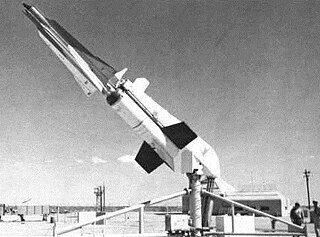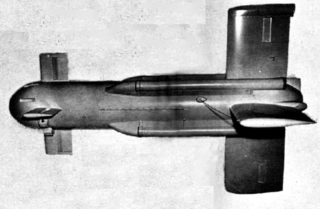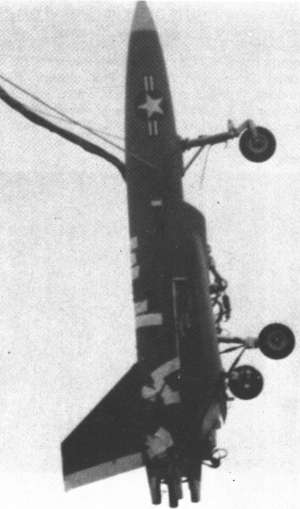Related Research Articles

The RIM-7 Sea Sparrow is a U.S. ship-borne short-range anti-aircraft and anti-missile weapon system, primarily intended for defense against anti-ship missiles. The system was developed in the early 1960s from the AIM-7 Sparrow air-to-air missile as a lightweight "point-defense" weapon that could be retrofitted to existing ships as quickly as possible, often in place of existing gun-based anti-aircraft weapons. In this incarnation, it was a very simple system guided by a manually aimed radar illuminator.

The AUM-N-2 Petrel, also known as Kingfisher C and AUM-2, was an air-to-surface missile produced as part of Project Kingfisher for the United States Navy. Intended to use against enemy surface ships and surfaced submarines giving aircraft the ability to deliver aerial torpedoes from outside the range of defensive armament, it saw brief operational service in the late 1950s. The project was never considered a high priority by the Navy however, as it was useless against submerged submarines, which were considered the greatest potential threat.

Operation Bumblebee was a US Navy effort to develop surface-to-air missiles (SAMs) to provide a mid-range layer of anti-aircraft defense between anti-aircraft guns in the short range and fighter aircraft operating at long range. A major reason for the Bumblebee efforts was the need to engage bombers before they could launch standoff anti-shipping weapons, as these aircraft might never enter the range of the shipboard guns.

Project Kingfisher was a weapons-development program initiated by the United States Navy during the latter part of World War II. Intended to provide aircraft and surface ships with the ability to deliver torpedoes to targets from outside the range of defensive armament, six different missile concepts were developed; four were selected for full development programs, but only one reached operational service.

The LBD-1 Gargoyle was an American air-to-surface missile developed during World War II by McDonnell Aircraft for the United States Navy. One of the precursors of modern anti-ship missiles, it was extensively used as a test vehicle during the late 1940s.

The Brazo missile was an American project of the 1970s, intended to produce an anti-radiation missile for air-to-air use. Developed by Hughes Aircraft and based on the AIM-7 Sparrow air-to-air missile, the Brazo underwent a series of successful test firings; however, the program was terminated at the end of its test program.

Typhon was a missile system developed by the United States Navy in the late 1950s, intended to serve as an integrated air-defense system for Navy fleets. Consisting of the SAM-N-8 Typhon LR, later designated RIM-50A, and the SAM-N-9 Typhon MR, later RIM-55A, paired with the AN/SPG-59 radar system, the cost of the Typhon system led to it being cancelled in favor of the Standard Missile program.

The RGM-59 Taurus was an American project, conducted by the United States Navy, that was intended to develop a surface-to-surface missile for use as a fire support weapon during amphibious landings, replacing heavy-caliber naval guns. Developed during the early 1960s, the project was cancelled before any hardware development was undertaken.

The Little Joe, also known by the United States Navy designation KAN, was an early American ship-based, short-range surface-to-air missile, the development of which was initiated in 1945 as a response to the Kamikaze tactics used by the Japanese. Although the missile was successfully tested, the end of World War II removed the requirement for the missile, and the project was abandoned in 1946.

The Interstate TDR was an early unmanned combat aerial vehicle — referred to at the time as an "assault drone" — developed by the Interstate Aircraft and Engineering Corporation during the Second World War for use by the United States Navy. Capable of being armed with bombs or torpedoes, 2000 aircraft were ordered, but only around 200 were built. The type saw some service in the Pacific Theater against the Japanese, but continuing developmental issues affecting the aircraft, along with the success of operations using more conventional weapons, led to the decision being made to cancel the assault drone program in October 1944.
The ZBGM-75 Advanced Intercontinental Ballistic Missile, also known as Weapons System 120A (WS-120A), was a program to develop an intercontinental ballistic missile (ICBM), proposed by the United States Air Force in the 1960s as a replacement for the LGM-30 Minuteman as the Air Force's standard ICBM. Funding was not allocated for the program and the project was cancelled in 1967.

The Hopi was an air-to-surface missile developed by the United States Navy's Naval Ordnance Test Station. Intended to provide a medium-range nuclear capability for carrier aircraft, the missile reached the flight test stage during 1958, but the project was cancelled following testing and no production was undertaken.

The MQR-16A Gunrunner was an unguided rocket developed by Atlantic Research during the 1960s. Designed with low cost as a priority, the MQR-16A was intended to act as a target drone for use in the development of man-portable surface-to-air missiles, and as a training target for the missile operators. Proving successful, the rocket served in the United States military until the 1980s.

The NSRDC XBQM-108A was an experimental VTOL unmanned aerial vehicle developed by the United States Navy during the 1970s. Although the XBQM-108A successfully conducted unmanned, tethered flight tests and the project was canceled before any free flights could be conducted.
The RIM-113 Shipboard Intermediate Range Combat System, or SIRCS, was an advanced surface-to-air missile proposed by the United States Navy in the 1970s. The project failed to be approved for funding and was cancelled in 1979.

The Creative Research On Weapons or Crow program was an experimental missile project developed by the United States Navy's Naval Air Missile Test Center during the late 1950s. Intended to evaluate the solid-fueled integral rocket/ramjet (SFIRR) method of propulsion as well as solid-fueled ramjet engines, flight tests were conducted during the early 1960s with mixed success.
RIM-101 was a short-lived project by the United States Navy to develop a surface-to-air missile (SAM) for the defense of naval vessels. Developed during the early 1970s, the project, possibly derived from the RIM-7 Sea Sparrow, was cancelled before the start of detailed design work.

The AGR-14 ZAP was an air-to-surface unguided rocket developed by the United States Navy in the late 1960s. Intended for use in the suppression of enemy air defenses role, the rocket reached the flight-testing stage before being cancelled.
The ASM-N-5 Gorgon V was an unpowered air-to-surface missile, developed by the Glenn L. Martin Company during the early 1950s for use by the United States Navy as a chemical weapon delivery vehicle. Developed from the earlier PTV-N-2 Gorgon IV test vehicle, the program was cancelled without any Gorgon Vs seeing service.

The AUM-N-6 Puffin, also known as Kingfisher F and AUM-6, was an anti-ship and anti-submarine missile developed for use by the United States Navy in the late 1940s. Pulsejet-powered and intended to allow an aircraft to launch a torpedo or bomb from stand-off range, it was flight-tested but failed to enter operational service.
References
- Notes
- Bibliography
- Andrade, John (1979). U.S. Military Aircraft Designations and Serials since 1909. Leicester, UK: Midland Counties Publications. ISBN 0-904597-22-9 . Retrieved 2011-01-26.
- Morison, Samuel L.; John S. Rowe (1975). The Ships & Aircraft of the U.S. Fleet (10th ed.). Annapolis, MD: United States Naval Institute. ISBN 0-87021-639-2.
- Parsch, Andreas (2002). "RIM-85". Directory of U.S. Military Rockets and Missiles. designation-systems.net. Retrieved 2011-01-26.
- Parsch, Andreas (2024). "Current Designations of U.S. Unmanned Military Aerospace Vehicles". designation-systems.net. Retrieved 2011-01-26.